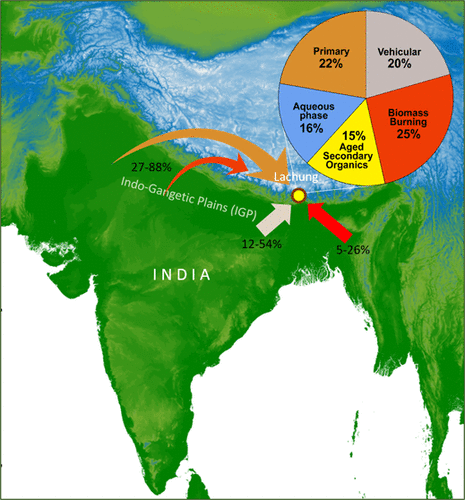当前位置:
X-MOL 学术
›
ACS Earth Space Chem.
›
论文详情
Our official English website, www.x-mol.net, welcomes your
feedback! (Note: you will need to create a separate account there.)
Carbonaceous Aerosols over Lachung in the Eastern Himalayas: Primary Sources and Secondary Formation of Organic Aerosols in a Remote High-Altitude Environment
ACS Earth and Space Chemistry ( IF 2.9 ) Pub Date : 2021-08-23 , DOI: 10.1021/acsearthspacechem.1c00190 B. S. Arun 1, 2 , Mukunda M. Gogoi 1 , Prashant Hegde 1 , Arup Borgohain 3 , Suresh K. R. Boreddy 1 , Shyam Sundar Kundu 3 , S. Suresh Babu 1
ACS Earth and Space Chemistry ( IF 2.9 ) Pub Date : 2021-08-23 , DOI: 10.1021/acsearthspacechem.1c00190 B. S. Arun 1, 2 , Mukunda M. Gogoi 1 , Prashant Hegde 1 , Arup Borgohain 3 , Suresh K. R. Boreddy 1 , Shyam Sundar Kundu 3 , S. Suresh Babu 1
Affiliation

|
The Himalayan and Tibetan Plateau, containing the largest ice mass outside the polar region, is very sensitive to the influence of carbonaceous aerosols. In this regard, year-round measurements of carbonaceous aerosols, along with major ionic species, were made over a remote high-altitude (2700 m a.s.l.) site Lachung in the eastern Himalayas to elucidate seasonal source signatures, transport, and secondary organic aerosol (SOA) formation pathways. The observation showed the dominance of organic carbon (OC) in winter (7.6 ± 2.6 μg m–3), having its highest fractional share (32%) to PM10 during both winter and summer. Elemental carbon (EC) concentrations as high as 1 μg m–3 and EC/PM10 > 5% indicated significant anthropogenic influence over this remote site. High OC/EC (5.5 ± 2.5) and the WSOC/OC (0.74 ± 0.15) ratios indicated the dominance of water-soluble secondary organic aerosol (SOA) throughout the year. During spring, the aqueous phase formation (APF) of aerosols was prominent, which is indicated by the strong correlation of aerosol liquid water content with WSOC and SO42–. Further, the positive matrix factorization model demonstrated the dominant contribution by biomass burning sources (>25%), followed by primary emission including mineral dust (22%) and vehicular and industrial emissions (20.5%). The role of north-westerly advection (∼88%) was highest in spring, increasing the OC and EC concentrations (∼70%). These observations univocally support the dominant contributions by anthropogenic aerosols to the eastern Himalayas.
中文翻译:

东喜马拉雅山 Lachung 上空的碳质气溶胶:偏远高海拔环境中有机气溶胶的主要来源和二次形成
喜马拉雅和青藏高原包含极地以外最大的冰块,对碳质气溶胶的影响非常敏感。在这方面,在喜马拉雅山脉东部的偏远高海拔 (2700 m asl) 站点 Lachung 对碳质气溶胶以及主要离子物质进行了全年测量,以阐明季节性源特征、传输和二次有机气溶胶。 SOA) 形成途径。观察结果表明,有机碳 (OC) 在冬季占主导地位 (7.6 ± 2.6 μg m –3 ),在冬季和夏季对 PM 10 的比例最高 (32%) 。元素碳 (EC) 浓度高达 1 μg m –3和 EC/PM 10> 5% 表示对该偏远地点的重大人为影响。高 OC/EC (5.5 ± 2.5) 和 WSOC/OC (0.74 ± 0.15) 比率表明全年水溶性二次有机气溶胶 (SOA) 占主导地位。春季气溶胶水相形成(APF)较为突出,气溶胶液态水含量与 WSOC 和 SO 4 2–有很强的相关性。. 此外,正矩阵分解模型表明生物质燃烧源的主要贡献(> 25%),其次是包括矿物粉尘在内的初级排放(22%)以及车辆和工业排放(20.5%)。西北风平流(~88%)的作用在春季最高,增加了 OC 和 EC 浓度(~70%)。这些观察结果明确支持人为气溶胶对喜马拉雅山脉东部的主要贡献。
更新日期:2021-09-16
中文翻译:

东喜马拉雅山 Lachung 上空的碳质气溶胶:偏远高海拔环境中有机气溶胶的主要来源和二次形成
喜马拉雅和青藏高原包含极地以外最大的冰块,对碳质气溶胶的影响非常敏感。在这方面,在喜马拉雅山脉东部的偏远高海拔 (2700 m asl) 站点 Lachung 对碳质气溶胶以及主要离子物质进行了全年测量,以阐明季节性源特征、传输和二次有机气溶胶。 SOA) 形成途径。观察结果表明,有机碳 (OC) 在冬季占主导地位 (7.6 ± 2.6 μg m –3 ),在冬季和夏季对 PM 10 的比例最高 (32%) 。元素碳 (EC) 浓度高达 1 μg m –3和 EC/PM 10> 5% 表示对该偏远地点的重大人为影响。高 OC/EC (5.5 ± 2.5) 和 WSOC/OC (0.74 ± 0.15) 比率表明全年水溶性二次有机气溶胶 (SOA) 占主导地位。春季气溶胶水相形成(APF)较为突出,气溶胶液态水含量与 WSOC 和 SO 4 2–有很强的相关性。. 此外,正矩阵分解模型表明生物质燃烧源的主要贡献(> 25%),其次是包括矿物粉尘在内的初级排放(22%)以及车辆和工业排放(20.5%)。西北风平流(~88%)的作用在春季最高,增加了 OC 和 EC 浓度(~70%)。这些观察结果明确支持人为气溶胶对喜马拉雅山脉东部的主要贡献。











































 京公网安备 11010802027423号
京公网安备 11010802027423号